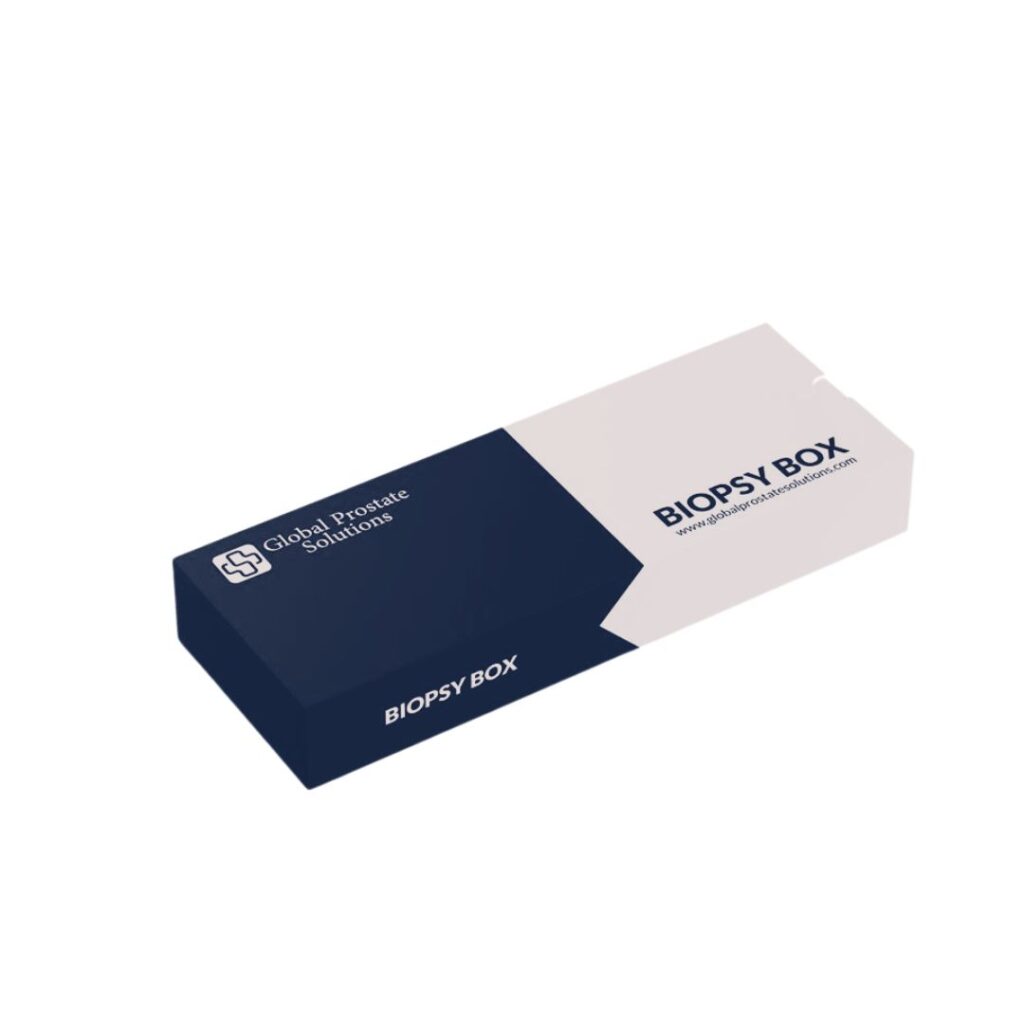If your doctor has suggested a prostate biopsy, you’re likely navigating a lot of information. Among the most common methods is the transrectal prostate biopsy, also known as a Transrectal Ultrasound (TRUS) biopsy. This procedure is a crucial step in diagnosing prostate concerns, especially when prostate cancer is suspected. Let us understand What is Transrectal Prostate Biopsy is and how it improves Prostate Cancer.
On this Page
What is Transrectal Prostate Biopsy?
A transrectal prostate biopsy is a popular procedure where small samples of tissues are taken directly from the patient’s prostate gland. A walnut sized prostate gland located just below the bladder in men, which produces fluid that forms part of semen.
The “transrectal” part means the biopsy needle is guided through the wall of the rectum (the back passage) to reach the prostate. This method uses real-time ultrasound imaging to help the doctor see the prostate and guide the needle accurately.
Understand What Transperineal Prostate Biopsy is.
Why is a Transrectal Prostate Biopsy Performed?
Your doctor might recommend a transrectal prostate biopsy if initial tests suggest a potential issue with your prostate. These indicators often include:
- Elevated PSA Levels: If your Prostate Specific Antigen (PSA) blood test shows levels higher than what’s normal for your age.
- Abnormal Digital Rectal Exam (DRE): If your doctor feels any lumps, hard spots, or unusual changes in your prostate during a physical exam.
- Suspicious MRI Scan: If an MRI of your prostate shows areas that look concerning, a biopsy can target these specific spots.
- Previous Atypical Biopsy: If a past biopsy showed abnormal but not cancerous cells (like Atypical Small Acinar Proliferation or High-Grade PIN).
The main goal is to check for Prostate Cancer and, if cancer is found, to understand how aggressive it might be.
How is a Transrectal Prostate Biopsy Done?
The transrectal prostate biopsy is typically an outpatient procedure, meaning you usually go home the same day. Here’s what generally happens:
- Preparation:
- You might be asked to take antibiotics a day or two before the procedure to help prevent infection.
- You may need to use an enema or laxative beforehand to clean out your rectum.
- Inform your doctor about any medications you take, especially blood thinners, as you might need to stop them for a few days.
- Positioning:
- You’ll usually lie on your side with your knees pulled up towards your chest, or sometimes on your stomach.
- Numbing the Area:
- The doctor will clean the area around the rectum with an antiseptic. Then, a local anesthetic will be injected around the prostate to numb the area and reduce discomfort. You might feel a brief sting or pressure.
- Ultrasound Guidance (TRUS):
- A thin ultrasound probe lubricated with Ultrasound gel is gently inserted into the rectum. This probe uses sound waves to create live images of your prostate on a screen, allowing your doctor to see exactly where to take samples.
- Taking Samples:
- Using the ultrasound guidance, the doctor will quickly project a thin, spring loaded needle through the rectal wall into different parts of the prostate. You might hear a “clicking” sound each time a sample is taken. Typically, 10 to 12 (or more) tiny tissue samples called “cores,” are collected from different areas of the prostate.
- Procedure Duration:
- The entire biopsy procedure usually takes about 10-20 minutes.

Advanced Prostate Cancer Test Kit in UK*!
Accuracy and Precision Promised.!!!
What to expect after a TRUS Biopsy?
During a TRUS Biopsy, you might feel pressure from the ultrasound probe and a brief, sharp pinch or “pop” each time a sample is taken, even with the anesthetic. Most people describe it as uncomfortable rather than severely painful.
Upon completing the TRUS Biopsy, you’ll likely be monitored for a short period before being discharged. But arrange some help, if you received any sedation.
What are the Common Side Effects of TRUS Biopsy?
Recovery from a transrectal prostate biopsy is usually quite quick. Most men can return to light normal activities within 24 to 48 hours. Let us understand some of the side effects of TRUS Biopsy.
- Blood in Urine: Urine may appear pink or light red for several days. Drinking plenty of fluids helps.
- Blood in Stool: A small amount of blood in your bowel movements for a few days.
- Blood in Semen (Hemospermia): This is very common and can last for several weeks or even months. Your semen may look reddish or rust-colored. Generally it is harmless.
- Mild Soreness/Discomfort: You might feel some tenderness or aching in the rectal or pelvic area. Over-the-counter pain relievers can help.
- Frequent or Urgent Urination: You might need to urinate more often for a day or two.
- Activity Restrictions: Your doctor will usually recommend avoiding strenuous exercise, heavy lifting, and sexual activity for about a week to allow the prostate to heal and reduce the risk of bleeding or infection.
What are the Risks for Transrectal Biopsy?
While generally safe, a transrectal prostate biopsy does carry some risks. Understand here the potential risk and complications of Transrectal Prostate Biopsy.
- Infection: This is the most significant concern, as the needle passes through the rectum, which contains bacteria. While antibiotics are given to help prevent this, infections (ranging from mild UTIs to more severe conditions like sepsis) can occur. Symptoms include fever, chills, severe pain, or difficulty urinating.
- Significant Bleeding: While minor bleeding is common, heavy or prolonged bleeding from the rectum or in the urine, or passing large blood clots, is a less common but serious complication.
- Difficulty Urinating (Urinary Retention): Swelling from the biopsy can sometimes make it hard to urinate, especially in men with pre-existing prostate enlargement. Rarely, a temporary catheter may be needed.
- Pain: While discomfort is expected, severe or worsening pain should be reported to the doctor.
How to understand the TRUS Biopsy Results?
After your biopsy, the tissue samples are sent to a pathologist, who examines them under a microscope. The results are crucial and typically take several days to a couple of weeks to come back. The common results are given below.
- Benign (No Cancer Found): This means no cancer cells were identified. However, it doesn’t 100% rule out cancer, as a very small cancer might have been missed. Doctors will discuss ongoing monitoring such as PSA tests.
- Benign Prostatic Hyperplasia (BPH): This is a non-cancerous enlargement of the prostate, a common age-related condition.
- Inflammation (Prostatitis): The biopsy might show signs of prostate inflammation.
- Atypical or Suspicious Cells: Sometimes, the cells look abnormal but are not clearly cancerous. This might be called Atypical Small Acinar Proliferation (ASAP) or High-Grade Prostatic Intraepithelial Neoplasia (HGPIN). These findings often lead to a recommendation for close monitoring or a repeat biopsy.
- Prostate Cancer: If cancer cells are found, the pathologist will also provide a Gleason Score. This score helps determine how aggressive the cancer is (lower scores like 6 are less aggressive; higher scores like 8-10 are more aggressive). The report will also detail how many biopsy cores contain cancer and the percentage of cancer in each core.
Conclusion
In conclusion, understanding What Transrectal Prostate Biopsy is important. A transrectal prostate biopsy is a common and vital diagnostic procedure for assessing prostate health and detecting prostate cancer. While it involves some temporary discomfort and minor risks, understanding the process, what to expect during recovery, and the potential results can help you feel more prepared and confident in managing your prostate health journey.
Consulting your Trusted Urologist and discussing the concerns help you stay informed about Prostate Health. Struggle in finding a Best Urologist in the UK? Contact Us, We can help it sorted.
FAQs
1. What is a transrectal prostate biopsy?
A transrectal prostate biopsy is a medical procedure used to diagnose prostate cancer. During the procedure, a doctor uses ultrasound guidance to pass a thin, hollow needle through the wall of the rectum and into the prostate gland to collect several small samples of tissue. The collected tissue samples are then sent to a laboratory where a pathologist examines them under a microscope to determine if cancer cells are present.
2. Is the transrectal prostate procedure painful?
Patients typically experience discomfort and pressure rather than sharp pain. To minimise pain, a local anesthetic is injected around the prostate gland before the biopsy samples are taken. You may feel a sensation of pressure from the ultrasound probe in your rectum.
3. What are the main risks and side effects?
While a transrectal prostate biopsy is generally safe, it does carry some risks and common, temporary side effects. Some of the side effects include the presence of blood in the urine, stool, and semen.
The primary risk is developing an infection because the needle passes through the rectal wall, which contains bacteria.
4. What happens after the biopsy?
After the biopsy, you will rest for a short observation period (usually around 30 minutes) before going home. You will be advised to avoid strenuous activity for the next 24-48 hours and to drink plenty of fluids to help flush your bladder. The tissue samples are sent to a pathology lab for analysis. It typically takes 5 to 10 working days to get the results.




